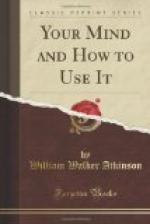“But, soft! What light through yonder window
breaks?
It is the east, and Juliet is the sun.
Arise, fair sun, and kill the envious moon,
Who is already sick and pale with grief
That thou, her maid, art far more fair than she.
Be not her maid, since she is envious;
Her vestal livery is but sick and green....
Two of the fairest stars in all the heaven,
Having some business, do entreat her eyes
To twinkle in their spheres till they return.
What if her eyes were there, they in her head?
The brightness in her cheek would shame those stars,
As daylight doth a lamp; her eyes in heaven
Would through the airy regions stream so bright
That birds would sing and think it were not night.
See, how she leans her cheek upon her hand!
O, that I were a glove upon that hand,
That I might touch that cheek!”
We may conclude, then, that three of the desirable attributes of great works of the imagination are number, variety and vividness of mental images.
One question that frequently arises concerning works of the imagination is, What is their source? Superficial thinkers have loosely answered, “Inspiration,” implying, (according to the literal meaning of the word, “to breathe in"), that some mysterious external force (called by the ancients, “A Muse”) enters into the mind of the author with a special revelation.
Psychological analysis of these imaginative works shows that this explanation is untrue. That the bizarre and apparently novel products arise from the experiences of the author, revived in imagination and combined in new ways. The horrendous incidents depicted in Dante’s “Divine Comedy” never occurred within the lifetime experience of the author as such. Their separate elements did, however, and furnished the basis for Dante’s clever combinations. The oft-heard saying that there is nothing new under the sun is psychologically true.
In the light of this brief analysis of products of the imagination we are ready to develop a program which we may follow in cultivating an active imagination.
Recognizing that images have their source in sensory experience, we see that the first step to take is to seek a multitude of experiences. Make intimate acquaintance with the objects of your environment. Handle them, tear them apart, put them together, place them next to other objects, noting the likenesses and differences. Thus you will acquire the stuff out of which images are made and will stock your mind with a number of images. Then when you wish to convey your ideas you will have a number of terms in which to do it—one of the characteristics of a free-flowing imagination.
The second characteristic we found to be variety. To secure this, seek a variety of sensational experiences. Perceive the objects of your experience through several senses—touch, smell, sight, hearing, taste. By means of this variety in sensations you will secure corresponding variety in your images.




